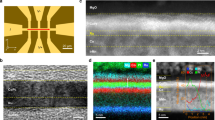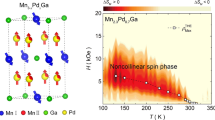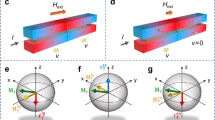Abstract
Voltage control of magnetic order is desirable for spintronic device applications, but 180° magnetization switching is not straightforward because electric fields do not break time-reversal symmetry. Ferrimagnets are promising candidates for 180° switching owing to a multi-sublattice configuration with opposing magnetic moments of different magnitudes. In this study we used solid-state hydrogen gating to control the ferrimagnetic order in rare earth–transition metal thin films dynamically. Electric field-induced hydrogen loading/unloading in GdCo can shift the magnetic compensation temperature by more than 100 K, which enables control of the dominant magnetic sublattice. X-ray magnetic circular dichroism measurements and ab initio calculations indicate that the magnetization control originates from the weakening of antiferromagnetic exchange coupling that reduces the magnetization of Gd more than that of Co upon hydrogenation. We observed reversible, gate voltage-induced net magnetization switching and full 180° Néel vector reversal in the absence of external magnetic fields. Furthermore, we generated ferrimagnetic spin textures, such as chiral domain walls and skyrmions, in racetrack devices through hydrogen gating. With gating times as short as 50 μs and endurance of more than 10,000 cycles, our method provides a powerful means to tune ferrimagnetic spin textures and dynamics, with broad applicability in the rapidly emerging field of ferrimagnetic spintronics.
This is a preview of subscription content, access via your institution
Access options
Access Nature and 54 other Nature Portfolio journals
Get Nature+, our best-value online-access subscription
$29.99 / 30 days
cancel any time
Subscribe to this journal
Receive 12 print issues and online access
$259.00 per year
only $21.58 per issue
Buy this article
- Purchase on Springer Link
- Instant access to full article PDF
Prices may be subject to local taxes which are calculated during checkout






Similar content being viewed by others
Data availability
Source data are provided with this paper. The XMCD spectra that support the findings of this study are publicly available at https://doi.org/10.5281/zenodo.4831735.
References
Fert, A., Cros, V. & Sampaio, J. Skyrmions on the track. Nat. Nanotechnol. 8, 152–156 (2013).
Parkin, S. S. P., Hayashi, M. & Thomas, L. Magnetic domain-wall racetrack memory. Science 320, 190–194 (2008).
Tsymbal, E. Y. Electric toggling of magnets. Nat. Mater. 11, 12–13 (2011).
Liu, L. et al. Spin-torque switching with the giant spin Hall effect of tantalum. Science 336, 555–558 (2012).
Heron, J. T. et al. Deterministic switching of ferromagnetism at room temperature using an electric field. Nature 516, 370–373 (2014).
Matsukura, F., Tokura, Y. & Ohno, H. Control of magnetism by electric fields. Nat. Nanotechnol. 10, 209–220 (2015).
Valencia, S. et al. Interface-induced room-temperature multiferroicity in BaTiO3. Nat. Mater. 10, 753–758 (2011).
Spaldin, N. A. & Ramesh, R. Advances in magnetoelectric multiferroics. Nat. Mater. 18, 203–212 (2019).
Baek, S. H. et al. Ferroelastic switching for nanoscale non-volatile magnetoelectric devices. Nat. Mater. 9, 309–314 (2010).
Fiebig, M., Lottermoser, T., Meier, D. & Trassin, M. The evolution of multiferroics. Nat. Rev. Mater. 1, 16046 (2016).
Cherifi, R. O. et al. Electric-field control of magnetic order above room temperature. Nat. Mater. 13, 345–351 (2014).
He, X. et al. Robust isothermal electric control of exchange bias at room temperature. Nat. Mater. 9, 579–585 (2010).
Mahmood, A. et al. Voltage controlled Néel vector rotation in zero magnetic field. Nat. Commun. 12, 1674 (2021).
Caretta, L. et al. Fast current-driven domain walls and small skyrmions in a compensated ferrimagnet. Nat. Nanotechnol. 13, 1154–1160 (2018).
Kim, K. J. et al. Fast domain wall motion in the vicinity of the angular momentum compensation temperature of ferrimagnets. Nat. Mater. 16, 1187–1192 (2017).
Cai, K. et al. Ultrafast and energy-efficient spin–orbit torque switching in compensated ferrimagnets. Nat. Electron. 3, 37–42 (2020).
Radu, I. et al. Transient ferromagnetic-like state mediating ultrafast reversal of antiferromagnetically coupled spins. Nature 472, 205–209 (2011).
Ueda, K., Mann, M., de Brouwer, P. W. P., Bono, D. & Beach, G. S. D. Temperature dependence of spin-orbit torques across the magnetic compensation point in a ferrimagnetic TbCo alloy film. Phys. Rev. B 96, 064410 (2017).
Katayama, T., Hasegawa, K., Kawanishi, K. & Tsushima, T. Annealing effects on magnetic properties of amorphous GdCo, GdFe, and GdCoMo films. J. Appl. Phys. 49, 1759–1761 (1978).
Ueda, K., Tan, A. J. & Beach, G. S. D. Effect of annealing on magnetic properties in ferrimagnetic GdCo alloy films with bulk perpendicular magnetic anisotropy. AIP Adv. 8, 125204 (2018).
Chaudhari, P., Cuomo, J. J. & Gambino, R. J. Amorphous metallic films for magneto‐optic applications. Appl. Phys. Lett. 22, 337–339 (1973).
Schelleng, J. H., Forester, D. W., Lubitz, P. & Vittoria, C. Hydrogenation and magnetic properties of amorphous rare-earth-iron (R-Fe) alloys. J. Appl. Phys. 55, 1805–1807 (1984).
Pourarian, F. Review on the influence of hydrogen on the magnetism of alloys based on rare earth-transition metal systems. Physica B 321, 18–28 (2002).
Stanciu, C. D. et al. All-optical magnetic recording with circularly polarized light. Phys. Rev. Lett. 99, 047601 (2007).
Kimel, A. V. & Li, M. Writing magnetic memory with ultrashort light pulses. Nat. Rev. Mater. 4, 189–200 (2019).
Tan, A. J. et al. Magneto-ionic control of magnetism using a solid-state proton pump. Nat. Mater. 18, 35–41 (2019).
Mushnikov, N. V., Goto, T., Gaviko, V. S. & Zajkov, N. K. Magnetic properties of crystalline and amorphous GdCo2Hx hydrides. J. Alloys Compd. 292, 51–56 (1999).
Knapton, A. G. Palladium alloys for hydrogen diffusion membranes. Platin. Met. Rev. 21, 44–50 (1977).
Tan, A. J. et al. Hydration of gadolinium oxide (GdOx) and its effect on voltage-induced Co oxidation in a Pt/Co/GdOx/Au heterostructure. Phys. Rev. Mater. 3, 064408 (2019).
Huang, M. et al. Voltage-gated optics and plasmonics enabled by solid-state proton pumping. Nat. Commun. 10, 5030 (2019).
Hansen, P. & Heitmann, H. Media for erasable magnetooptic recording. IEEE Trans. Magn. 25, 4390–4404 (1989).
Tsuchida, T., Sugaki, S. & Nakamura, Y. Magnetic properties of GdCo2 and Gd1–xYxCo2. J. Phys. Soc. Japan 39, 340–343 (1975).
Lemaire, R. & Schweizer, J. Variation du moment magnetique du cobalt dans les composes GduY1−uCo2. Phys. Lett. 21, 366–368 (1966).
McGuire, T. R. & Gambino, R. J. Hall effect in amorphous Gd alloy films. J. Magn. Magn. Mater. 15–18, 1401–1403 (1980).
Nagaosa, N., Sinova, J., Onoda, S., MacDonald, A. H. & Ong, N. P. Anomalous Hall effect. Rev. Mod. Phys. 82, 1539–1592 (2010).
Finley, J. & Liu, L. Spin-orbit-torque efficiency in compensated ferrimagnetic cobalt-terbium alloys. Phys. Rev. Appl. 6, 054001 (2016).
Niemier, M. T. et al. Nanomagnet logic: progress toward system-level integration. J. Phys. Condens. Matter 23, 493202 (2011).
Breitkreutz, S. et al. Controlled reversal of Co/Pt dots for nanomagnetic logic applications. J. Appl. Phys. 111, 07A715 (2012).
Haldar, A., Kumar, D. & Adeyeye, A. O. A reconfigurable waveguide for energy-efficient transmission and local manipulation of information in a nanomagnetic device. Nat. Nanotechnol. 11, 437–443 (2016).
Choudhury, S. et al. Voltage controlled on-demand magnonic nanochannels. Sci. Adv. 6, eaba5457 (2020).
Rapoport, E., Montana, D. & Beach, G. S. D. Integrated capture, transport, and magneto-mechanical resonant sensing of superparamagnetic microbeads using magnetic domain walls. Lab Chip 12, 4433–4440 (2012).
Chen, C. et al. Voltage manipulation of magnetic particles using multiferroics. J. Phys. D 53, 174002 (2020).
Zhang, D. et al. Enhancement of tunneling magnetoresistance by inserting a diffusion barrier in L10-FePd perpendicular magnetic tunnel junctions. Appl. Phys. Lett. 112, 152401 (2018).
Zhang, D. et al. L10 Fe-Pd synthetic antiferromagnet through an fcc Ru spacer utilized for perpendicular magnetic tunnel junctions. Phys. Rev. Appl. 9, 044028 (2018).
Miron, I. M. et al. Perpendicular switching of a single ferromagnetic layer induced by in-plane current injection. Nature 476, 189–193 (2011).
Zhao, Z., Smith, A. K., Jamali, M. & Wang, J. External‐field‐free spin Hall switching of perpendicular magnetic nanopillar with a dipole‐coupled composite structure. Adv. Electron. Mater. 6, 1901368 (2020).
Streubel, R. et al. Experimental evidence of chiral ferrimagnetism in amorphous GdCo films. Adv. Mater. 30, 1800199 (2018).
Emori, S., Bauer, U., Ahn, S.-M., Martinez, E. & Beach, G. S. D. Current-driven dynamics of chiral ferromagnetic domain walls. Nat. Mater. 12, 611–616 (2013).
Fukami, S. & Ohno, H. Perspective: spintronic synapse for artificial neural network. J. Appl. Phys. 124, 151904 (2018).
Huang, M. Voltage Control of Electrical, Optical and Magnetic Properties of Materials by Solid State Ionic Transport and Electrochemical Reactions. PhD thesis, Massachusetts Institute of Technology (2020).
Gilbert, D. A. et al. Controllable positive exchange bias via redox-driven oxygen migration. Nat. Commun. 7, 11050 (2016).
Lee, K.-Y. et al. Fast magneto-ionic switching of interface anisotropy using yttria-stabilized zirconia gate oxide. Nano Lett. 20, 3435–3441 (2020).
Caretta, L. et al. Interfacial Dzyaloshinskii-Moriya interaction arising from rare-earth orbital magnetism in insulating magnetic oxides. Nat. Commun. 11, 1090 (2020).
Barla, A. et al. Design and performance of BOREAS, the beamline for resonant X-ray absorption and scattering experiments at the ALBA synchrotron light source. J. Synchrotron Radiat. 23, 1507–1517 (2016).
Vasili, H. B. et al. Direct observation of multivalent states and 4f→3d charge transfer in Ce-doped yttrium iron garnet thin films. Phys. Rev. B 96, 014433 (2017).
Chen, C. T. et al. Experimental confirmation of the X-ray magnetic circular dichroism sum rules for iron and cobalt. Phys. Rev. Lett. 75, 152–155 (1995).
Teramura, Y., Tanaka, A., Thole, B. T. & Jo, T. Effect of Coulomb interaction on the X-ray magnetic circular dichroism spin sum rule in rare earths. J. Phys. Soc. Japan 65, 3056–3059 (1996).
Ostler, T. A. et al. Crystallographically amorphous ferrimagnetic alloys: comparing a localized atomistic spin model with experiments. Phys. Rev. B 84, 024407 (2011).
White, H. W., Beaudry, B. J., Burgardt, P., Legvold, S. & Harmon, B. N. Magnetic moments of ferromagnetic gadolinium alloys. AIP Conf. Proc. 29, 329 (1976).
Mansuripur, M. & Ruane, M. Mean-field analysis of amorphous rare earth-transition metal alloys for thermomagnetic recording. IEEE Trans. Magn. 22, 33–43 (1986).
Kresse, G. & Furthmüller, J. Efficient iterative schemes for ab initio total-energy calculations using a plane-wave basis set. Phys. Rev. B 54, 11169–11186 (1996).
Perdew, J. P. et al. Restoring the density-gradient expansion for exchange in solids and surfaces. Phys. Rev. Lett. 100, 136406 (2008).
Dudarev, S. & Botton, G. Electron-energy-loss spectra and the structural stability of nickel oxide: an LSDA+U study. Phys. Rev. B 57, 1505–1509 (1998).
Evans, R. F. L. et al. Atomistic spin model simulations of magnetic nanomaterials. J. Phys. Condens. Matter 26, 103202 (2014).
Towns, J. et al. XSEDE: accelerating scientific discovery. Comput. Sci. Eng. 16, 62–74 (2014).
Acknowledgements
This work was supported in part by the US National Science Foundation (NSF) through the Massachusetts Institute of Technology Materials Research Science and Engineering Center (MRSEC) under award number DMR-1419807 and through NSF award number ECCS-1808828, by SMART, one of seven centres of nCORE, a Semiconductor Research Corporation program, sponsored by the National Institute of Standards and Technology (NIST), by DARPA ERI FRANC program under HR001117S0056-FP-042, by the DARPA TEE program under HR001117S0038-D18AC0019, by the Korea Institute of Science and Technology (KIST) Institutional Program (2E31032) and a National Research Council of Science and Technology (NST) grant (CAP-16-01-KIST) by the Korea government (MSIP), and by the German Science Foundation (DFG) under project 400178764. This work used the Extreme Science and Engineering Discovery Environment (XSEDE) computational resources provided through allocation TG-DMR190038. The work was performed using the facilities in the MIT Microsystems Technology Laboratory and in the Center for Materials Science and Engineering, supported by the NSF MRSEC program under award number DMR-1419807. Portions of this work were conducted in the Minnesota Nano Center, which is supported by the NSF through the National Nanotechnology Coordinated Infrastructure (NNCI) under award number ECCS-2025124. M.V. and P.G. acknowledge additional funding through grants from MINECO FIS2016-78591-C3-2-R (AEI/FEDER, UE) and FLAG-ERA SographMEM (PCI2019-111908-2). M.H. acknowledges financial support from the Kavanaugh Fellows Program in the Department of Materials Science and Engineering at MIT. L.C. acknowledges financial support from the NSF Graduate Research Fellowship and the GEM Consortium. The authors thank L. Liu for use of ion-milling equipment.
Author information
Authors and Affiliations
Contributions
M.H. and G.S.D.B conceived and designed the experiments. G.S.D.B., J.C., K.L., B.Y. and J.-P.W. supervised the respective members of the study. M.H., M.U.H., D.Z., D.L. and J.Z. fabricated the samples. M.H., M.U.H. and J.Z. performed MOKE and electrical characterizations. S.S., A.C., P.G., M.V. and M.H. conducted the XMCD measurements. M.H. and F.B. processed the XMCD measurements with help from M.V. and P.G. M.H. carried out the mean-field modelling. K.K. performed the ab initio and spin dynamics calculations. M.H. set up the temperature-dependent MOKE apparatus with help from L.C. K.-Y.L. performed the structural and chemical analyses. M.H. wrote the manuscript with guidance from G.S.D.B. All authors discussed the results and commented on the manuscript.
Corresponding author
Ethics declarations
Competing interests
The authors declare no competing interests.
Additional information
Peer review information Nature Nanotechnology thanks Christian Binek, Morgan Trassin and the other, anonymous, reviewer(s) for their contribution to the peer review of this work.
Publisher’s note Springer Nature remains neutral with regard to jurisdictional claims in published maps and institutional affiliations.
Supplementary information
Supplementary Information
Supplementary Figs. 1–7 and Discussion.
Supplementary Video 1
Time sequence of the coercivity and hysteresis loop when VG is cycled between +3 and −1.5 V.
Source data
Source Data Fig. 1
Numerical data used to generate the graphs in the figures.
Source Data Fig. 2
Numerical data used to generate the graphs in the figures.
Source Data Fig. 3
Numerical data used to generate the graphs in the figures.
Source Data Fig. 4
Numerical data used to generate the graphs in the figures.
Source Data Fig. 5
Numerical data used to generate the graphs in the figures.
Rights and permissions
About this article
Cite this article
Huang, M., Hasan, M.U., Klyukin, K. et al. Voltage control of ferrimagnetic order and voltage-assisted writing of ferrimagnetic spin textures. Nat. Nanotechnol. 16, 981–988 (2021). https://doi.org/10.1038/s41565-021-00940-1
Received:
Accepted:
Published:
Issue Date:
DOI: https://doi.org/10.1038/s41565-021-00940-1
This article is cited by
-
Solar manipulations of perpendicular magnetic anisotropy for flexible spintronics
Frontiers of Physics (2024)
-
Large exchange bias enhancement and control of ferromagnetic energy landscape by solid-state hydrogen gating
Nature Communications (2023)
-
Electrically programmable magnetic coupling in an Ising network exploiting solid-state ionic gating
Nature Communications (2023)
-
Molecular magneto-ionic proton sensor in solid-state proton battery
Nature Communications (2022)
-
Manipulating the insulator–metal transition through tip-induced hydrogenation
Nature Materials (2022)



